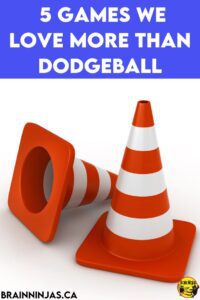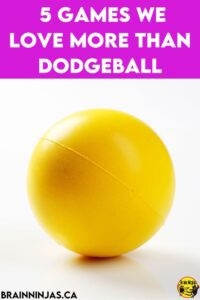
As a student, I hated dodgeball with a passion. I wore glasses and could barely see without them, but I wasn’t allowed to wear them in case they were broken. So, there I would be, blind as a bat, wandering around, trying not to get pelted by those giant red rubber balls that always left a mark. I saw a pattern immediately. The few top athletes (usually the biggest boys) knocked everyone out, usually hurting them in the process and then continued playing amongst themselves while the rest of us sat bored on the sidelines licking our wounds.
I vowed, as a teacher, I would never let any of my students experience that. This means there is no dodgeball in any of my gym classes. These are some of the games we love to play instead.

Noodle Hockey
Materials: Pool noodles, a soft ball (like a Nerf ball), goal posts or a net (optional – we just use a line on the floor).
This is just like floor hockey, but instead of plastic, hard sticks and pucks, use soft (like Nerf) balls and pool noodles. It’s lots of fun, and your superstar hockey players are on an equal playing field with your clumsy team players.
How to play: Each team has one goalie whose job is to prevent the ball from entering the goal area. Each team has five other players who will try to get the ball into the opponent’s goal area using their pool noodles.
Instead of scoring in a net, you could count a point if it crosses a specific line.
Skittles

Skittles is a traditional European lawn game that is similar to bowling, but this is not that game. This is a classroom favourite out of all the games we love.
Materials: One skittle per student (for example, a block of wood, a bowling pin, or a pylon with a small ball on top) and a variety of balls that can be thrown (and don’t hurt if they accidentally hit students). These objects are better if they stand independently but can be easily knocked over (empty 2L plastic pop bottles work well).
How to Play: Students place their skittle somewhere in the designated space. If it falls over at any point in the game, they are not allowed to throw any more balls. This includes knocking over their own skittle (be really clear about that). We don’t allow students to place their skittle against anything like a wall or bench. It has to be freestanding.
When the game starts, students will pick up balls and toss them at the skittles of other players. They can run anywhere and knock down a skittle from any direction, but they cannot knock it down by touching it directly.
Students can play offensively by running around and trying to knock down other skittles, but if their skittle drops, they must stop throwing immediately. If your students are playing too defensively, make a rule that they cannot stand within one metre of their skittle (or further).
Keep playing until there is a winner.
Variation to keep the game moving: If lots of students have been knocked out, choose a code word that immediately refreshes the game. When you call the code word, everyone can stand their skittle back up and start playing again.
Variation if you don’t have enough skittles: Divide the class into two teams. Place the same number of skittles on either side for each team. Play the same way, but instead of being knocked out individually, one team is trying to knock down all the skittles of the opposing team.
Junkyard

This is a silly game that, for whatever reason, our students loved. It is also a great game to help get all the equipment sorted and organized in your equipment room. If everything in your equipment room is mixed up, this can be a fun way to fix that.
Materials: Everything you can safely throw.
How to Play: Divide the class into two teams. Place as much random equipment as you can in the middle between the two teams.
When the whistle blows (or whatever you use as a starting point), students will try to clear all the junk from their side of the gym before the next whistle blows.
As the referee, choose a random amount of time until you will stop the game.
When the game stops, count out the number of pieces of equipment on each side. The lowest number wins.
How to make this into an organization activity: After each round, collect all of one item so that it can be put away in the equipment room properly.
KanJam
This is a popular outdoor game that we modified for our class.
Materials: Two big, empty garbage bins or buckets (hula hoops on the ground work, too), frisbees (we use 2-4). If you don’t have frisbees, just use a lightweight foam ball.
How to Play: Place the goals at either end of the gym and divide the class into two teams.
The object of the game is to score points by landing the frisbee in the goal. If it’s too difficult to get your frisbee into a goal, try choosing a zone instead.
One team has all the frisbees, and one at a time, they will toss the frisbee, trying to get a goal. When a player tosses a frisbee at the goal, the opposing team players can try to deflect it, but they cannot use their hands, and they cannot catch it. This means they need to be careful about not standing with their faces directly in the path of the goal.
If a frisbee lands in the goal area, the team that threw it gets a point. The first team to get 21 points wins.
We use a class list just to make sure everyone on each team gets to take a turn. An editable name checklist can be found in our Resource Library, along with many other general classroom forms to help you organize your classroom. Or we can send it directly to your inbox when you sign up for our email list.
If you are looking to play KanJam with the actual equipment and rules, then check out this video.
Bean Bag Bocce

This is a variation on Bocce Ball that we use with our students.
Materials: Two bean bags of the same colour per student or partnership, one other coloured bean bag per group of four.
How to Play: Put students in partners. They will have two bean bags that are the same colour. Each partnership will play against another partnership that has a different colour set of bean bags. Their game will have one more bean bag that is a different colour.
The game starts with one person tossing the other coloured bean bag. This is the jack. Now, each player will try to toss their bean bag as close to the jack as possible. After all four bean bags are tossed, the one that lands closest to the jack scores a point. If two bean bags of the same colour are closest, the team gets two points.
Once the scoring is done, the person who scored the point picks up the jack and tosses it somewhere else. Play continues.
The first team to 21 wins.
We play this indoors during the winter, but once the outdoor fields dry out, we take the games we love outside.
Do you teach physical education?
While we like to play the games we love, sometimes we don’t have the equipment to play. That’s the thought behind our post: Energize Your Gym Class With Very Little Equipment. We have lots of games we love that are actually playground games. They don’t use too much equipment, and often, students haven’t heard of them, so they are new(ish): Why You Should Revive Old Playground Games.
If your students need some work being good teammates, your class might benefit from our Classroom Community Unit. It is a collection of activities designed to help students learn to work together, collaborate, communicate and work towards a common goal. Find it in our TPT Store ($USD) or BN Shop ($CAN).
These games we love are a staple in our gym class, but sometimes we just play for fun. What are some of your favourite games to play that don’t involve throwing things directly at students? Let us know in the comments below.







